Cervical ribs
Cervical ribs are an uncommon anomaly sometimes causing pain and tingling in arms and hands.
Normally speaking, only the twelve thoracic vertebrae have a pair of ribs, beginning at the spine, and attached to the sternum or other lower rib cartilage, and a couple of "floating ribs", forming the ribcage.
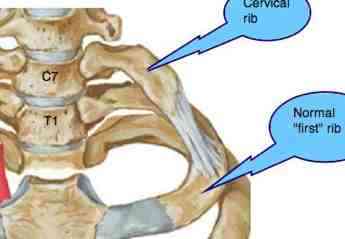
This page was last updated by Dr Barrie Lewis on 7th June, 2019.
This vital structure serves to protect the vital organs, particularly the heart, but is moveable to allow breathing.
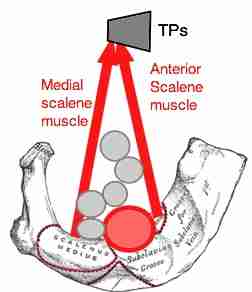
Tingling in arms and hands
Cervical rib syndrome
At the upper end of the thoracic spine, at the junction with the neck, normally T1, the first thoracic vertebra has the first rib. But in 2 per 1000 people, there is a rib above the first rib. A cervical rib.
If there is a cervical rib then it penetrates through a very restricted passage called the interscalene triangle bounded by the first rib below, and two muscles, the scalenes on the sides of the triangle.
Why all the hype? Because at the cervico thoracic junction is the critical area where the large artery, the subclavian artery, and a large group of nerves, called the brachial plexus, emerge from the chest cavity to supply the arm.
The significance is that this syndrome may produce a crazy mixture of both arterial and neurological deficiency in the arm.
These ribs are usually rudimentary and of little or no clinical significance, but occasionally a very large space occupying cervical rib, originating from the transverse process of the lowermost cervical vertebra, passing through the inter scalene triangle and joining onto the normal first rib, may cause severe symptoms in the arm.
Remember, normally the cervical vertebrae have no ribs. Ribs pertain to the thoracic vertebrae.
A vascular and or neurological restriction in the inter scalene triangle is known as a thoracic outlet syndrome producing classically pain and tingling in the arm, particularly when lifting the arms as in hanging washing.
Interscalene triangle
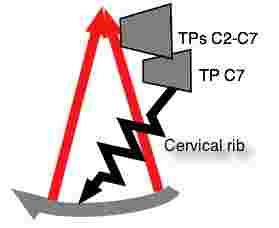
ADSON'S TEST
However a low grade irritation
in the inter scalene triangle is often the underlying cause of a
frozen shoulder
for example, or a
carpal tunnel syndrome.
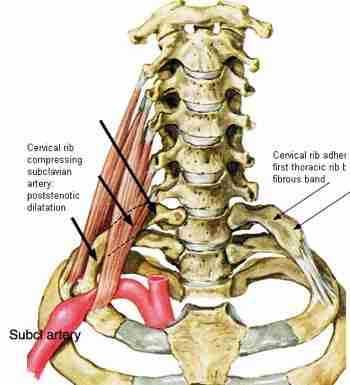
Notice how the cervical rib can affect both the subclavian artery above, and the lowermost cord of the brachial plexus both.
So, both artery and nerve symptoms and signs are possible, though not necessarily so.
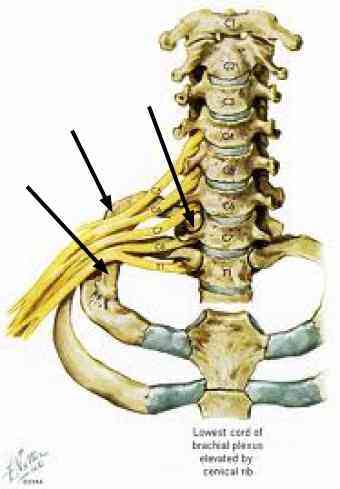
The classical test to confirm a thoracic outlet syndrome is the test of Adson. Your chiropractor will locate your radial pulse in the wrist, and then ask you to turn your head and breathe in. Does the pulse die away, and return when you return your head to neutral and breathe out?
It's a difficult test, very subjective, and I like to do it with the arm on the lap to eliminate false positives. Done in the normal way with the arm abducted and externally rotated many quite normal people have a positive Adson's test.
The key sign that will alert your chiropractor to the fact that all is not well in the state of Denmark, is that she simply can't find a radial artery pulse in the wrist. The first time it happened to me, I was bowled over: how could there be no pulse in the arm? Had my palpation skills suddenly diminished? Nope, a very large cervical rib.
There's just enough blood getting through to the arm when it's at rest, but start to use the muscles in your arm, or raise your arm so the inter scalene triangle is further diminished in size, and bingo, pain and tingling in the arm.
It's known as intermittent claudication, not dissimilar to angina. When the body is at rest, there's enough blood to supply the muscles. But as soon as you start to exercise, the muscles require more oxygen, and there's not enough. Pain.
So, of course, it's quite impossible to do Adson's test if you can't locate the radial pulse. An xray is mandatory.
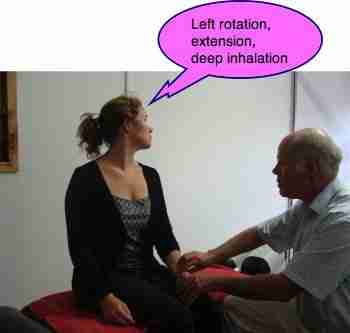
This is a similar position of the head and neck for Spurling's test; does the pain immediately radiate down the arm?
Cervical ribs
What is hard to explain is that the C7 rib lies silently in the inter scalene triangle for years minding its own business, its owner none the wiser. Then suddenly, one day, for no obvious rhyme or reason, the arm starts to ache and tingle.
It may have a carpal tunnel syndrome appearance, or a frozen shoulder, or tennis arm; the signs and symptoms are very variable.
In the case below, I believe it was taking a job where the patient took a job and started holding the phone between her neck and shoulder, a real no-no that could have been the trigger that provoked the incipient rib to start giving her pain and tingling in the arms and hands.
Why didn't it cause pain years ago? If there's a big lump of bone in the way, how on earth can chiropractic help.
The medical treatment for the offending rib is not nice. The surgeon enters the inter scalene triangle via the arm pit, and surgically removes the offending rib. Frankly, I have no idea how successful the operation is, or what the morbidity is, but it's very close to extremely sensitive structures, the brachial plexus, the subclavian artery and the apex of the lung.
I have had numerous letter from patients at chiropractic help complaining that the operation either didn't help, or the condition was worsened because of injury to the brachial plexus.
- Arm Pain Case Histories (use the site search function in the navigation bar to locate this)
- Telephone and the pinched nerve in neck
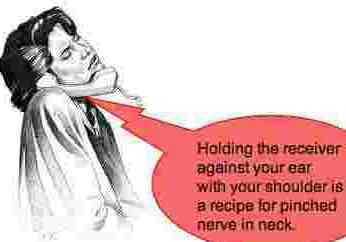
PANCOAST TUMOUR
Talking of lungs, in you have tingling in the arms and hands, and are a smoker and have a bad cough, your chiropractor should consider a nasty tumour in the apex of the lung that can mimic a C7 Rib.
You do know, don't you, that smoking will knock ten years off your life, and the end will most likely be very S-H-one-T?

CHIROPRACTIC CARE
It's not well understood why the Cervical Rib suddenly starts to misbehave. In fact, we think that often the symptoms are not caused by the rib at all - otherwise, if the Cervical Rib was there ten years ago, why was there no pain and tingling in the arms and hands back then?
But it is an aggravating factor, the space in the Inter Scalene Trianle is even more limited than normal.
The thinking is that there is either a fixation of the first Thoracic Rib, or the Scalene muscles go into spasm because of a Cervical Facet Syndrome or perhaps a whiplash, poor posture at the computer (do you have support under your elbow?), sleeping on your tum, or anyone of a host of other facts. Long journey, sleeping in an aeroplane...
Can Chiropractic help?
A guarded yes, the hesitation because there aren't enough cases for us to do reliable research, which would tell you that in 80% (or 50%, or 10%) of cases chiropractic management of the Scalene muscles, the cervical vertebrae, the first rib can help you. Here you can follow a casefile currently under treatment. Very successfully, I might say, but a "cure" is unlikely, like many medical conditions and chiropractic conditions too. Cervical Rib CaseFile ...
Thoracic outlet syndrome vs cervical rib
Cervical ribs are but one cause of the so-called Thoracic Outlet syndrome. Any invasive process, be it a cervical rib or a Pancoast tumour, or an old fracture of the first rib or clavicle can irritate and impinge on the Subclavian artery and the Brachial plexus.
But so can a Scalene spasm, be it due to a whiplash, cervical facet syndrome, sleeping in the upright position, long journeys... or an imbalance between the Trapezius msucles and the the smaller Scalenes and SCMs for example.
From a chiropractic standpoint, a fixated first rib is another very common cause of the Thoracic Outlet Syndrome, causing scalene muscle spasm, but with no invasion of the inter scalene triangle.
CLOT Very occasionally a clot may form in the subclavian vein causing swelling of the whole arm. This is a very serious condition requiring immediate medical attention. Intial treatment would probably be blood thinners and perhaps a stent.
Further resection of the first rib, and if present a cervical rib, may be necessary, but it's a difficult operation, not without attendant dangers:
"1st rib resection of my left shoulder (2 months ago) has squared up my shoulders but has increased the strain on my neck, mid and lower back. Nerve damage sustained due to the operation has serverely effected the first three fingers with hyper sensitivity, signs of muscle wasteage around the base of the thumb and forearm is apparent. Overall I have ailments from the finger tips through the wrist up my arm, within my elbow and shoulder down the spine,at the base of my back through my left hip joint and in the back of the knee."
Letter received at Chiropractic Help.
First lumbar rib
At the lower end of the thoracic spine, quite often the first lumbar vertebra may have a rib, and it may be very significant in the patient who has four (known as a sacralisation) or six (known as a lumbarisation) lumbar vertebrae, instead of the usual five.
Here is a typical sacralization of L5 casefile.
Did you find this page useful? Then perhaps forward it to a suffering friend. Better still, Tweet or Face Book it.
